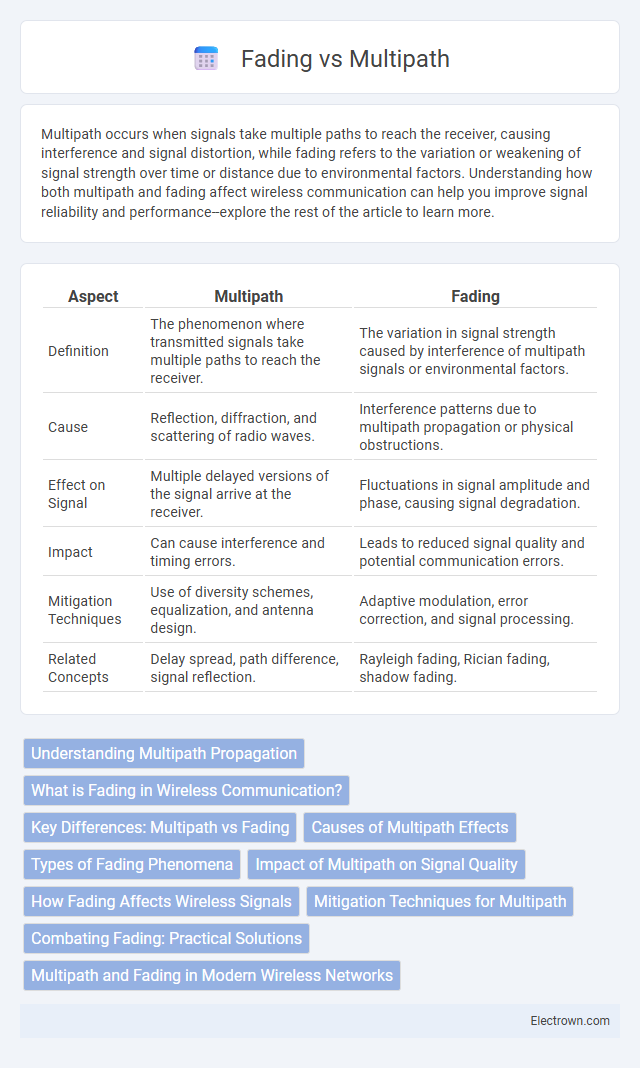Multipath occurs when signals take multiple paths to reach the receiver, causing interference and signal distortion, while fading refers to the variation or weakening of signal strength over time or distance due to environmental factors. Understanding how both multipath and fading affect wireless communication can help you improve signal reliability and performance--explore the rest of the article to learn more.
Table of Comparison
| Aspect | Multipath | Fading |
|---|---|---|
| Definition | The phenomenon where transmitted signals take multiple paths to reach the receiver. | The variation in signal strength caused by interference of multipath signals or environmental factors. |
| Cause | Reflection, diffraction, and scattering of radio waves. | Interference patterns due to multipath propagation or physical obstructions. |
| Effect on Signal | Multiple delayed versions of the signal arrive at the receiver. | Fluctuations in signal amplitude and phase, causing signal degradation. |
| Impact | Can cause interference and timing errors. | Leads to reduced signal quality and potential communication errors. |
| Mitigation Techniques | Use of diversity schemes, equalization, and antenna design. | Adaptive modulation, error correction, and signal processing. |
| Related Concepts | Delay spread, path difference, signal reflection. | Rayleigh fading, Rician fading, shadow fading. |
Understanding Multipath Propagation
Multipath propagation occurs when transmitted radio signals reach a receiver via multiple paths caused by reflections, diffractions, and scattering from buildings, terrain, and other obstacles. This phenomenon leads to signal fading, where varying path lengths cause constructive and destructive interference, resulting in fluctuations in signal strength and quality. Understanding multipath effects is critical for optimizing wireless communication systems, improving signal reliability, and designing robust anti-fading techniques such as diversity schemes and equalization.
What is Fading in Wireless Communication?
Fading in wireless communication refers to the variation or attenuation of signal strength over time or space caused by factors such as multipath propagation, atmospheric conditions, and obstacles blocking the line of sight. It results in fluctuations in the received signal's amplitude, phase, or frequency, leading to decreased signal quality and communication reliability. Understanding fading mechanisms, including Rayleigh and Rician fading models, is crucial for designing robust wireless systems that mitigate signal degradation through techniques like diversity, equalization, and adaptive modulation.
Key Differences: Multipath vs Fading
Multipath occurs when transmitted signals reach the receiving antenna by multiple paths due to reflection, diffraction, and scattering, resulting in overlapping signals. Fading describes the variation in signal strength over time or space caused by factors like multipath interference, atmospheric conditions, or mobility. While multipath is a propagation phenomenon causing signal replicas, fading is the resultant fluctuation in received signal amplitude and quality.
Causes of Multipath Effects
Multipath effects arise when transmitted signals reflect off various surfaces like buildings, mountains, or vehicles, causing multiple signal paths to arrive at the receiver at different times. These reflections result in signal interference, leading to fluctuations known as fading in wireless communication. Environmental factors such as terrain irregularities, obstacles, and atmospheric conditions significantly influence the severity of multipath-induced signal fading.
Types of Fading Phenomena
Multipath fading occurs when multiple signal paths cause constructive or destructive interference, leading to rapid fluctuations in signal amplitude and phase. Common types of fading phenomena include flat fading, where all frequencies are equally affected, and frequency-selective fading, which impacts certain frequency components differently due to varying path delays. Understanding these fading types helps you design robust wireless communication systems to mitigate signal degradation effectively.
Impact of Multipath on Signal Quality
Multipath causes multiple signal copies to arrive at the receiver with different delays and phases, resulting in constructive and destructive interference that degrades signal quality through fading. This fading leads to fluctuations in signal amplitude and phase, reducing communication reliability and increasing error rates. Understanding multipath effects is crucial for designing robust wireless systems with improved signal clarity and performance.
How Fading Affects Wireless Signals
Fading causes fluctuations in wireless signal strength due to variations in the propagation environment, such as obstacles, reflections, and atmospheric conditions. Multipath fading occurs when multiple signal paths cause constructive or destructive interference, leading to rapid signal strength changes and potential loss of data integrity. Understanding fading behavior is crucial for designing robust communication systems that mitigate signal degradation and improve reliability.
Mitigation Techniques for Multipath
Multipath interference occurs when multiple signal paths cause overlapping and distortion, leading to signal fading and reduced communication quality. Techniques such as spatial diversity, equalization, and adaptive beamforming effectively mitigate multipath effects by enhancing signal clarity and reliability. Your wireless system's performance can improve significantly by implementing these advanced signal processing methods to counteract multipath fading.
Combating Fading: Practical Solutions
Combating fading in wireless communication involves employing multipath techniques such as diversity reception, equalization, and error correction coding to mitigate signal degradation caused by multiple signal paths. Implementing spatial diversity through multiple antennas helps in combating Rayleigh and Rician fading by selecting or combining the strongest signal paths. Adaptive modulation and channel estimation further enhance reliability by dynamically adjusting transmission parameters in response to real-time fading conditions.
Multipath and Fading in Modern Wireless Networks
Multipath occurs when wireless signals take multiple paths to reach the receiver, causing signal copies to arrive at different times and potentially interfere with each other. Fading refers to the variation in signal strength due to factors such as multipath propagation, obstacles, and environment changes, leading to fluctuations in the quality of your wireless connection. Modern wireless networks employ advanced techniques like diversity schemes, equalization, and MIMO technology to mitigate multipath effects and minimize fading, ensuring more reliable communication.
Multipath vs Fading Infographic

 electrown.com
electrown.com